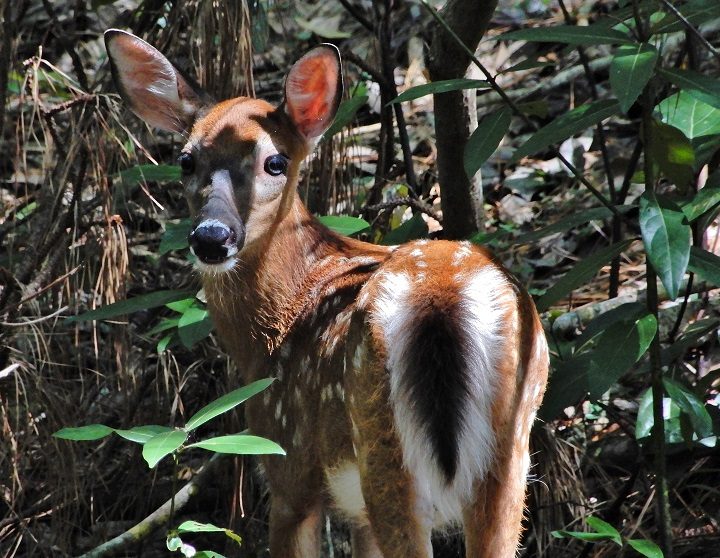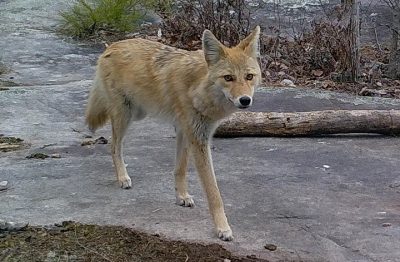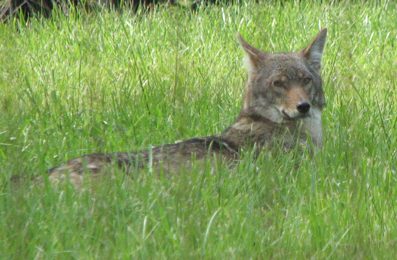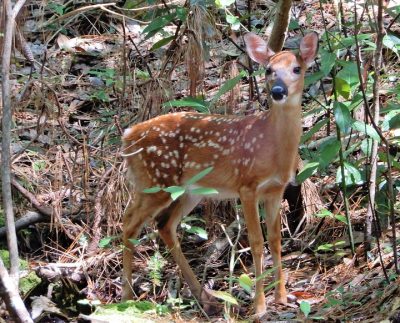
EMERALD ISLE – This Bogue Banks town has been working to manage two distinct wildlife populations in an urban setting: coyotes and deer.
An opportunity to learn more about the town’s urban wildlife management program will take place Feb. 19 during the monthly Police Educating the Public, or PEP, class starting at 10 a.m. in the town board meeting room in the police department. This month’s class will review how to coexist with wildlife, including how to avoid attracting coyotes and choosing deer-resistant plants.
Supporter Spotlight
“Our goal is not eradication, our goal is management,” said Police Chief Tony Reese about the town’s urban wildlife management program. The program is dictated by a biologist with the state Wildlife Resources Commission. “We follow his guidelines to the letter.”

The town works with Chris Kent, who began serving in November 2015 as the District 2 coastal regional wildlife biologist for the North Carolina Wildlife Resources Commission. His district consists of the 12 southeastern counties from Pitt to New Hanover.
Kent said that he attends town meetings to provide biological information about coyotes and help property owners manage coyotes. He also visits with town officials to discuss deer-related concerns such as property damage, vehicle collisions, resident complaints and disease issues.
He performs the annual survey of the deer population on Bogue Banks, typically in September, but didn’t in 2018 because of Hurricane Florence.
Following the Food
The wildlife has moved into the populated town because, “Deer, and coyotes for that matter, require food, water and shelter,” all of which are in abundance in Emerald Isle, Kent said.
Supporter Spotlight
“The deer showed up long before coyotes. Prior to the arrival of coyotes, deer had little to no hunting pressure and no natural predators,” Kent said, adding there were plenty of ornamental flowers, plants and shrubs and dense maritime forests for cover, which allowed them to flourish.

“Coyotes showed up likely following food sources,” Kent continued, explaining that the coyotes also had no hunting or trapping pressure and no natural predators. “Food sources such as feral cats, squirrels, rabbits, marsh rodents and raccoons were in abundance, so they flourished as well. The dense maritime forest and thick, natural areas allow for sheltered den sites. Both good examples of why hunting and trapping are valuable tools in the wildlife management toolbox.”
Reese, the police chief, said that all the communities on Bogue Banks are dealing with coyotes, which are present in every county in the state.
“Coyotes were really never prominent east of the Mississippi,” he said. “It’s only been over the last 25 to 30 years that they’ve migrated this way. A lot of people believe the reason for that was the extinction of the red wolf in North Carolina, which was a known predator of coyotes.”
Town residents started speaking up in 2015 about the presence of coyotes. Reese said that when they talked to the WRC biologist, his initial recommendation was to leave coyotes alone. “That’s the recommendation that we followed.”
Following continued concerns from the public, the town in the fall of 2016 responded by removing the town ordinance prohibiting coyote trapping.
“All the town really did was remove the town ordinance prohibiting it and require people to follow the state law with regards to the coyote trapping season in North Carolina,” he said. “We have removed our restriction on trapping coyotes only and the only other restriction we put on it was that if you’re going to trap, you need to let the police know so that we can monitor … as part of our management work.”

Trapping season in North Carolina is Dec. 1-Feb. 28, which is when a the town brings in a licensed trapper to catch coyotes on public property. Private property owners must follow the state law pertaining to trapping coyotes. The trapper must have a trapping license and is required to carry written permission from the property owner at all times.
“We’re basically making them follow the state law in regards to trapping,” he added.
The town first implemented the trapping season Dec. 1, 2016, to Feb. 28, 2017. In the first year, 14 coyotes were trapped on public property, “the largest of which was 65 pounds, which is huge for a coyote. We caught several in the 50-pound range. Last year, we trapped 12 coyotes,” Reese said. The town had trapped five as of Tuesday for this year.
When the 2016 survey was completed by WRC, it was estimated that Emerald Isle had anywhere from 40 to 80 coyotes. “Since we started the trapping program in 2016, our complaints have gone way down, our sightings have gone way down … our catch numbers have gone way down.”
He said they’re still trapping in the same areas where they’d typically find coyotes or see signs of coyotes, “but we’re just not seeing the numbers we used to see.”
Nothing to Fear
Most people have nothing to fear from the animal.
“Coyotes try to avoid contact with humans,” Reese said, adding that coyotes will be attracted to food scraps, grease, small dogs and uncovered barbecue pits. “Anything that would release scents would attract coyotes to the property.”

He emphasized that dogs should not be left unattended or off leash because coyotes are extremely clever hunters. They’ll lead the animal on a chase and take it back to the pack where it will be attacked by multiple coyotes. “They’re almost like velociraptors.”
He said if you come across a coyote, make yourself as big as possible and yell. “Coyotes are like any other animal, they’re going to remember areas that they didn’t have good experiences in and they’ll try to avoid those areas.”
In his research, Reese said he learned that most people that have been bitten by a coyote were trying to feed it because the person treated the coyote as if it were a dog. But it’s not, it’s a wild animal. “The coyote’s demeanor is extremely deceiving, they’ll take a submissive posture, and they’re trying to draw you in … they’re very smart animals.”
Reese said the public is always notified when trapping is underway. There’s a book at the front desk of the police department where anyone trapping in Emerald Isle “is required to come in and register their traps, the location of traps, when the traps are set, when they harvest, male or female … all that information is given to the biologists,” he said.
He said that the coyotes Emerald Isle traps are later euthanized. Transporting wildlife in North Carolina is illegal because if an animal that is trapped is diseased, the disease could spread in the area it was transported. The trapper Emerald Isle uses sells the pelts in the fur trade.
Managing the Deer Population
The town’s deer program is an example of why population management has been the goal, Reese explained.
The deer depredation program that began in 2010 is modeled after the Food and Drug Administration program. The Wildlife Resources Commission performed a deer count survey and the findings showed that Emerald Isle was severely overpopulated with deer and they were seeing a lot of disease. “There were concerns about chronic wasting disease, seeing deer with a lot of tumors, just a lot of sick deer … our island was overpopulated, there were not enough resources to healthfully support the herd of deer we have over here.”

WRC recommended that Emerald Isle harvest a set number of deer each year determined by the biologist to get to a healthy population.
The police department solely conducts the annual hunts, which are with bow and arrow. “We don’t let any civilians participate, everyone who participates in that hunt is a sworn law enforcement officer,” Reese said. Adding that the two officers on the hunt are expert bow shooters and the hunts usually take place between 11 p.m. and 4 a.m.
”I’m there for every single one, I have to approve every shot that’s taken,” adding that the deer have to be on public property, not private, when the deer are harvested.
Reese said there’s a survey most every year of the deer population, usually in September or October. The deer depredation hunt usually takes place in January and February.
“In 2016 we conducted a survey and had gotten the population down, it wasn’t as low as what the biologist wanted, but it was close, and we determined we didn’t need to do a hunt that year,” he added.
The town didn’t conduct a survey in 2018 because of Hurricane Florence, but officials plan to later this year.
With the deer depredation program, “the method we’re using has had a twofold effect,” Reese said. “One, we’ve been able to reduce the population to a healthy number and we’re seeing a lot healthier herd but in addition to that, the way we’re conducting the hunt has caused the deer to shy away from the roadways … and so we’ve seen our deer collisions with motor vehicles reduced by 400 percent.”
The reported accidents involving deer in 2012-13 were 28. “Last year we had two,” he said. There were 31 in 2013-14. Then after two years of the program, the accidents reduced to nine.
“What we’ve seen over the years is significant decreases in complaints with regards to both coyotes and deer because of the programs we’re doing,” Reese said.
Public response to the programs has been mixed, he explained. While some think that the town shouldn’t be engaging in the deer depredation program, others want all deer eradicated.
Reese said that all of the meat from the deer depredation program is processed and donated to Hope Mission in Morehead City to feed the hungry. The town pays for the meat processing at a professional facility.
“The last two years that we did the hunt, we donated between 800 and 1,000 pounds of meat,” he said.
Vital statistics are also taken of the deer that are harvested.
“We only harvest does, we don’t harvest bucks, the reason is that if you can control the doe population, you’re more effective at controlling the deer population,” he said. “When we harvest the does, we count fetuses … age of the deer, try to make annotations of any abnormalities that are noticed, those types of things.”
The information collected is supplied to the Wildlife Resources Commission biologist, who will use those details to base recommendations for subsequent programs.
“Our goal is to strike that balance and have a management program that provides a healthy environment with a healthy population so we don’t have any public safety or public health risks,” he said.
Kent said it appears the deer population has stabilized to a healthy and more acceptable level. Based on conversations with Reese, “he has told me that they do not regularly observe deer with disease issues anymore” and the number of vehicle collisions and resident complaints are way down also. “I believe they only recorded two vehicle collisions last year in Emerald Isle.”
Learn More
- Contact the Wildlife Conflict Hotline at 866-318-2401 from 8 a.m. to 5 p.m. to speak with a biologist.







